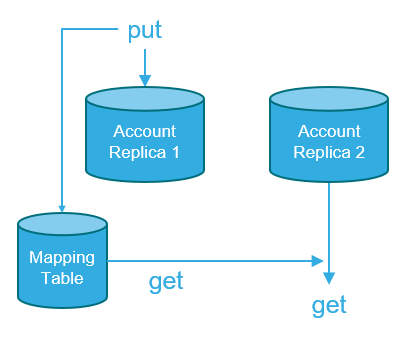Eventual Consistency In Google Cloud Datastore
Back to the days when I work with relational databases, I was barely worried about data consistency problem. DBMS of SQL DB can take care of it as a basic property. However, NoSQL databases have emerged in recent years and are playing more and more important roles with strong scalability. In NoSQL databases, data consistency is not always a basic property anymore.
The Problem
The project I am working on is backed by Google Cloud Datastore. In the project, we have Customer model and Account model. The key in Customer model is built on customer_id, and the key of the Account model is built on account_id.
Recently, we wanted to add a restriction that each customer can only have one account. My first attempt was to run a query on the Account model before creating the account. The simplified code is like this:
class Account(ndb.Model):
@classmethod
def lookup_for_customer_id(cls, customer_id, keys_only=False):
return cls.query(cls.customer_id == customer_id).get(keys_only=keys_only)
@classmethod
def create_or_get(cls, customer_id, kwargs):
account = Account.lookup_for_customer_id(customer_id)
if account:
return account.account_id
else:
def tx():
# call TinyId for a unique ID
account_id = Account.generate_account_id()
key = Account.build_key(account_id)
account_entity = Account(key=key, **kwargs)
account_entity.put()
return account_entity
account = ndb.Transaction(tx)
return account.account_id
I had two problems here:
- It is possible that the query in
lookup_by_customer_idgets a stale result in which a recently created account is missing due to the consistent problem. - If I move the query into the transaction, Datastore will give me an error
Bad Request - queries inside transactions must have ancestors. So, the query has to happen out of the transaction, and this brings potential race condition issue in the high-concurrency application.

To solve these problems, let's start with two consistency models in Google Cloud Datastore.
Strong Consistency and Eventual Consistency
In Datastore, there are two levels of data consistency:
- Strongly Consistency: queries guarantee the most up-to-date results, but may take longer to complete or may not be supported in certain cases.
- Eventual Consistency: queries generally run faster, but may occasionally return stale results.
Consistency Model of Query APIs
| Cloud Datastore API | Read of entity value | Read of index |
|---|---|---|
| Global Query | Eventual consistency | Eventual consistency |
| Keys-only Global Query | N/A | Eventual consistency |
| Ancestor Query | Strong consistency | Strong consistency |
| Lookup by key (get()) | Strong consistency | N/A |
Global Query
Queries without an ancestor are known as Global Queries and designed to work with an eventual consistency model.
account = Account.query().filter('customer_id =', customer_id).get()
Keys-only Global Query
A keys-only global query is a global query that returns only the keys of entities matching the query, not the attribute values of the entities.
account = Account.query().filter('customer_id =', customer_id).get(keys_only=True)
Ancestor Query
An ancestor query limits its results to the specified entity and its descendants. When calling get (by key), Cloud Datastore will flush all pending updates on one of the replicas and index tables, then execute get.
ancestor = Customer.build_key(customer_id)
account = Account.query(ancestor=ancestor).get()
Lookup by key
The lookup by key call returns one entity or a set of entities specified by a key or a set of keys.
account_key = Account.build_key(account_id)
account = account_key.get()
The Solution
At the end of the day, I decided to create a new mapping table between customer_id and account_id, in which the key was built on customer_id. The code was updated to:
class Account(ndb.Model):
@classmethod
def lookup_for_customer_id(cls, customer_id, keys_only=False):
mapping = Mapping.get(customer_id)
if not mapping:
return None
account_key = cls.build_key(mapping.account_id)
if keys_only:
return account_key
else
return account_key.get()
@classmethod
def create_or_get(cls, customer_id, kwargs):
def tx():
account = Account.lookup_for_customer_id(customer_id)
if account:
return account
else:
# call TinyId for a unique ID
account_id = Account.generate_account_id()
account_key = Account.build_key(account_id)
account_entity = Account(key=account_key, **kwargs)
account_entity.put()
mapping_key = Mapping.build_key(customer_id)
mapping_entity = Mapping(key=mapping_key, account_id)
mapping_entity.put()
return account_entity
account = ndb.Transaction(tx, xg=True)
return account.account_id
In this chunk of code, get() on both Mapping and Account model can guarantee strong consistency. Similarly, the code of Account.delete() was also updated, so that when an Account entity was deleted, the corresponding Mapping entity should be deleted as well. Moreover, I ran a MapReduce to populate the data into Mapping model for all the existing Account entities.

Problem solved!
According to the consistency model of APIs, some other solutions could also solve the consistency problem. However, they have some downsides to my problem.
-
Using Ancestor Query Downside: I have to rebuild all the data in
Accountmodel to introduce ancestor path in their keys. This operation might even require some downtime. -
Appending
account_idfield inCustomermodel Downside: Actually, this could be a good solution, but it does not suit our situation. TheCustomermodel in this project is a replication of the customer data in another project. As this situation is against the idea of the single source of truth, some of my co-workers are planning to eliminateCustomermodel in this project.
By the way, projects in my company are migrating from Datastore to Spanner. In the official documents of Spanner, a new concept "External Consistency" is introduced. I will be looking into that later, and I hope not to have consistency problem again.